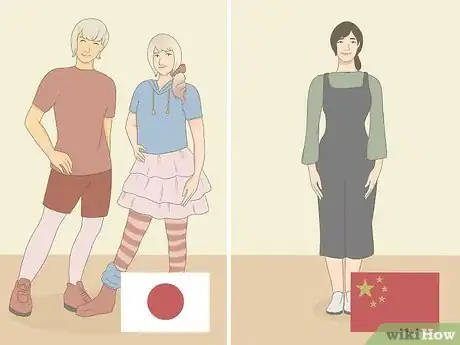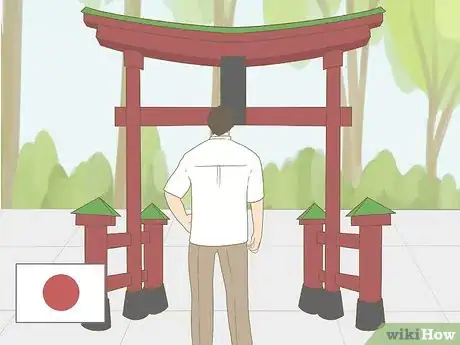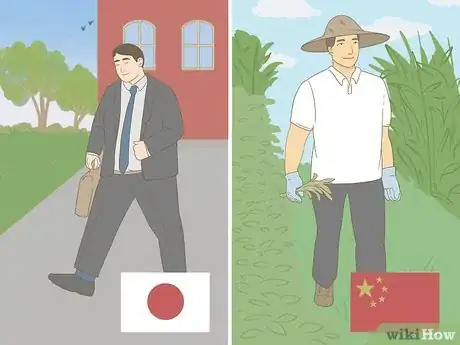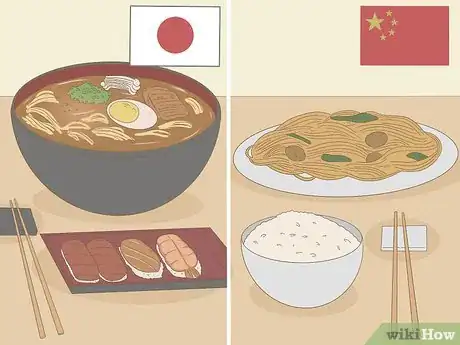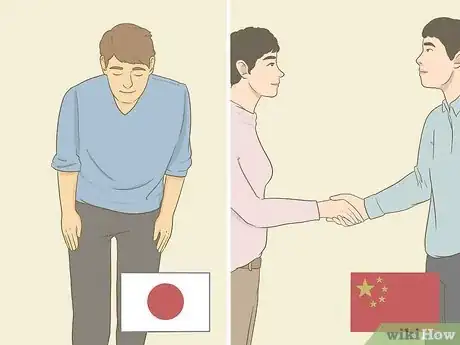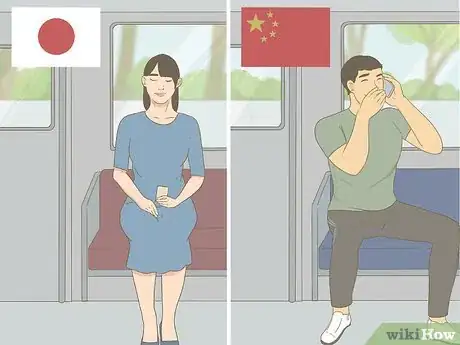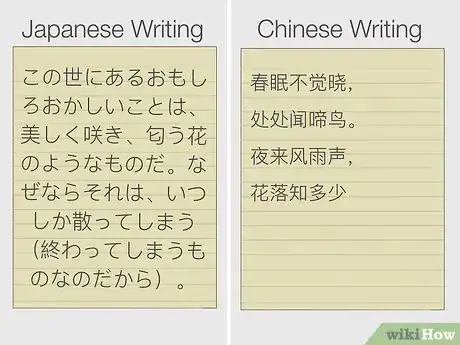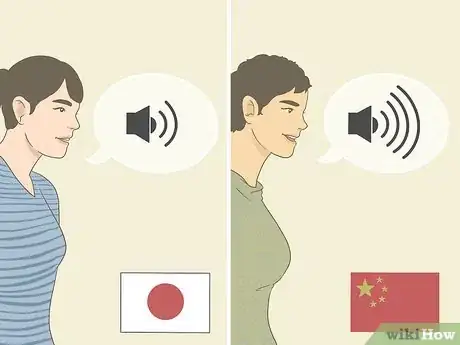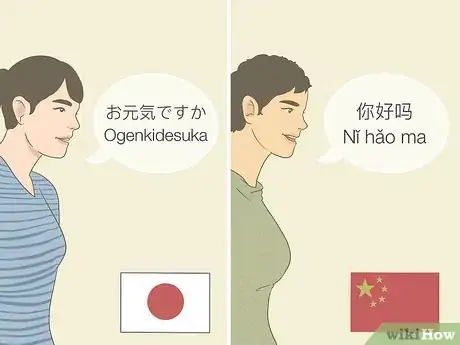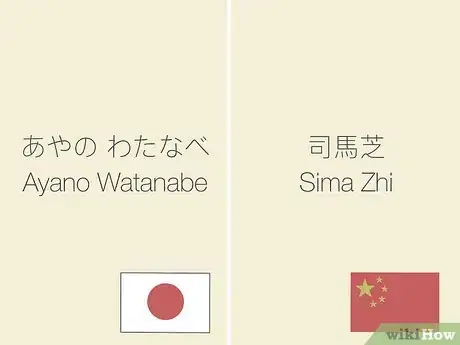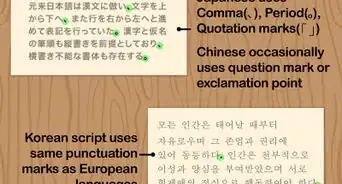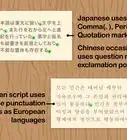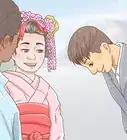This article was co-authored by wikiHow staff writer, Jennifer Mueller, JD. Jennifer Mueller is a wikiHow Content Creator. She specializes in reviewing, fact-checking, and evaluating wikiHow's content to ensure thoroughness and accuracy. Jennifer holds a JD from Indiana University Maurer School of Law in 2006.
There are 8 references cited in this article, which can be found at the bottom of the page.
This article has been viewed 511,018 times.
Learn more...
To Western eyes and ears, it may be difficult to tell Japanese and Chinese people and cultures apart. However, to an Asian, the two are as different as American culture is from Russian culture. Once you can identify basic differences, it'll become easier for you to distinguish between the two. Understanding a little bit about the languages and social cues of each culture helps you better understand the profound differences between these two Asian cultures.
Steps
Identifying Basic Differences
-
1Observe the value placed on politeness and social harmony. While both cultures are relatively polite compared to most Western cultures, the Japanese place far more emphasis on manners and social hierarchy than the Chinese do. In Japanese society, you would never be casual or familiar with someone who was significantly older than you or held a higher social rank.[1]
- While both the Chinese and the Japanese are more formal with older people, the Japanese people are also more formal even with people who are only a year or two older. For example, if you were in your first year of study at a Japanese university, you would be polite and formal with fellow students who were in their second year of study.
- The Japanese observe high levels of self-discipline and decorum in public. You would rarely see Japanese people arguing or expressing anger with each other publicly, while the Chinese don't necessarily have a problem with this.
-
2Recognize the global spread of Japanese pop culture. While the Chinese aren't particularly motivated to capitalize on their popular culture, Japanese popular culture is a global commodity. Manga comic books, anime, and Harajuku street fashion are all fairly well known in Western cultures.[2]
- Much of the pop culture difference comes from the difference between the governments of the two countries. China has a communist government and economy, which makes it a much less consumer-based society. Japan, in contrast, has a booming capitalist system that feeds its citizens' desires to be enriched and entertained.
- China's films and music tend to be filled with government propaganda and a strong political agenda, which means they aren't very popular outside the country.
Advertisement -
3Evaluate the role of religion in daily life. Because China is a communist country, many Chinese embrace atheism. Yet due to the influence of Buddhism and Taoism for thousands of years, most Chinese still believe in the traditional religions but do not practice often. Temples can be seen around the country, some have witnessed hundreds years of history. Japanese people tend to be far more religious, following both Buddhist and Shinto belief systems.[3]
- Japanese temples and sacred gardens are located throughout the country, and elaborate formal ceremonies are public occasions.
- Many Japanese also attend Christian churches, a practice that is far less common in China.
-
4Understand the differences in geography and demographics. China is slightly smaller than the contiguous United States, while Japan is slightly smaller than the state of California. The difference in land area means that Japan is far more urbanized than China. Chinese people primarily work in agriculture and industrial production while most Japanese people work in the service sector.[4]
- Because of China's size, it is difficult to generalize about a universal Chinese culture. Different regions of China have their own customs, traditions, and beliefs. China is more diverse while Japan tends to be more homogenized.
- As an island, Japan has remained relatively isolated from external influences throughout history. This makes Japan's culture unique compared to many others. In contrast, Chinese traders have long been exposed to many different cultures and nationalities and incorporated various styles, beliefs, and practices.[5]
-
5Distinguish Chinese food from Japanese food. The Japanese tend to eat a lot of fresh and raw food, particularly seafood, while the Chinese more often fry things. While rice and noodles feature prominently in both Chinese and Japanese diets, they are cooked much differently and have different flavor profiles.
- Rice in China is typically fried and mixed with vegetables, eggs, and sauce. Japanese rice is more often sticky rice. While rice may serve as the base for a Chinese meal, in Japan it is more often offered as a side dish.
- Japanese fresh vegetables are typically steamed and served separately, while Chinese vegetables are usually fried along with the meat and mixed together.
Tip: While both cultures eat with chopsticks, the style is slightly different. Japanese chopsticks have rounded ends and tend to be shorter than Chinese chopsticks.
Reading Social Cues
-
1Watch for a bow to accompany greetings. Both Chinese and Japanese people tend to bow when greeting people for the first time. However, the Japanese are far more strict about bowing, with entire protocols based on the level of seniority and age of the person you're greeting.[6]
- In China, the bow is more typically replaced with a Western-style handshake unless you're greeting an elder. Chinese people may nod their head to show respect while shaking hands. In contrast, a short nod of the head in Japan would be considered rude unless you were greeting a close friend who was the same age as you or younger.
-
2Listen to the volume of people's voices when they're speaking. The Japanese customarily are quiet in public. On public transportation, Japanese people will frequently turn the ringers off on their phones and tend not to carry on conversations. When people do speak in public, it is in hushed tones.[7]
- The Chinese, in contrast, don't have any cultural prohibition against speaking loudly or talking on the phone in public places. So if you see a group of Asian people laughing and talking loudly, they're more likely to be Chinese than Japanese.
Tip: Volume may not be the best indicator of nationality if you're listening to someone in a Western country. Depending on how long they've lived there, they may have adopted local customs.
-
3Pay attention to gestures and nonverbal communication. Both Chinese and Japanese culture rely extensively on nonverbal communication. Japan, in particular, places greater emphasis on strict social hierarchies. You can distinguish between Japanese and Chinese cultures by looking at how close people stand when they talk to one another and how respectful and submissive their body language is.[8]
- For example, in China, silence is often seen as agreement to do something. If the person disagrees, they will more likely talk around the negative and stress the commonalities before telling you what they'd rather do.
- Because the Chinese language is tonal, Chinese people cannot rely on their tone of voice to communicate their meaning. This makes gestures and body language far more important than they would be otherwise.
- For the Japanese, nonverbal communication is more a sign of respect and politeness. The deepness of your bow and the distance you stand from someone when talking all indicate their standing in relation to you.
Recognizing Differences in Language
-
1Look for Japanese characters in a piece of writing. While both Chinese and Japanese written languages use Chinese characters (known as hànzì in Chinese and kanji in Japanese), Japanese also uses a phonetic script called hiragana. If you see hiragana characters in a piece of writing, you're looking at something Japanese.[9]
- Hiragana characters are curvy and light, and some of them are actually kind of cute. They're usually pretty easy to tell apart from the angular, complex kanji. One character, in particular, to look for is の. It occurs relatively frequently and looks like nothing in Chinese script. If you see this character, you can be assured you're looking at something Japanese.
- The Japanese have a more angular script, katakana, that is used for loan words transliterated from another language, such as English.
Tip: While Japanese has 3 different writing scripts, there is only one Japanese language. In contrast, China has only one script but numerous different languages that use the same script (just as there are numerous languages that use the Latin alphabet).
-
2Listen for changes in tone when a person is speaking. All Chinese languages are tonal languages, meaning that the rise or fall in the tone of a person's voice changes what word they're saying. Spoken Chinese often has a sing-song flow to Western ears.[10]
- In contrast, Japanese is a relatively monotone language. Japanese speakers may modulate the tone of their voice to express emotion or intention, as you would in English if you raised your tone at the end of a sentence to indicate a question.
-
3Pay attention to vowel sounds. The Japanese language only has 5 vowel sounds (fewer than English) and about 100 different syllables that can be arranged in limited ways. If you hear few vowel sounds or variations between words, you're likely listening to a Japanese person speak.[11]
- Chinese, on the other hand, has multiple vowel sounds depending on a vowel's position in a word and the tone in which it is said. If you hear a lot of variation in vowel sounds, you're likely listening to someone speaking Chinese.
-
4Consider the ending of a word. Chinese words can end in any letter, and many Chinese words end in consonants. In contrast, a Japanese word can only end in a vowel or the letter "n."[12]
- If you're listening to someone speak in a relatively monotone voice and all of the words end in a vowel, you can be fairly confident that they're speaking Japanese.
-
5Figure out someone's nationality based on their name. There are far more Japanese surnames than there are Chinese surnames. A Japanese surname might be 2 or 3 syllables long and almost always ends in a vowel. In contrast, a Chinese surname is typically only one syllable and ends in a consonant.[13]
- Keep in mind that if someone was born in a Western country, they may have a first name common in that country, rather than a traditional Japanese or Chinese name. You still may be able to determine their nationality by looking at their surname.
References
- ↑ https://web.uri.edu/iaics/files/03LinTao.pdf
- ↑ http://www.waseda.jp/gsaps/eaui/educational_program/images/winter_school/Lecture6_Kitti.pdf
- ↑ https://travelandculture.expertscolumn.com/comparing-japanese-chinese-cultures
- ↑ https://www.indexmundi.com/factbook/compare/china.japan
- ↑ https://travelandculture.expertscolumn.com/comparing-japanese-chinese-cultures
- ↑ https://blog.gaijinpot.com/japanese-korean-chinese/
- ↑ https://blog.gaijinpot.com/japanese-korean-chinese/
- ↑ https://online.pointpark.edu/business/cultural-differences-in-nonverbal-communication/
- ↑ https://www.lingualift.com/blog/tell-chinese-japanese-korean-apart/

